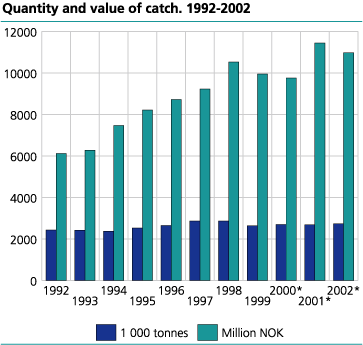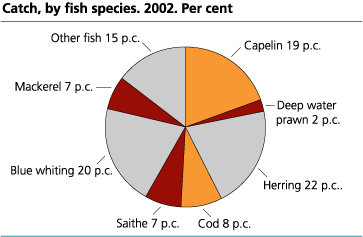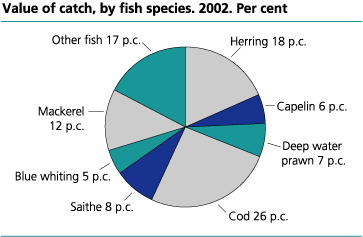Content
Published:
This is an archived release.
More capelin, less herring
The annual catch of capelin was six times higher in 2002 than five years earlier. In the same period, the catch of herring decreased by more than 30 per cent. Preliminary figures as of 20 January 2003 show that Norwegian vessels delivered 2.7 million tonnes of fish in 2002, about the same as the preliminary figure for 2001.
Including crustaceans and molluscs, the landed value amounted to nearly NOK 11 billion. In 2001 the value was NOK 11.4 billion.
227 000 tonnes of cod
The cod catch came to 227 000 tonnes worth NOK 2.8 billion. This accounts for 8 per cent of the total catch quantity and 26 per cent of the catch value. Among the landed value of catch, the cod fishing is the most important.
The herring catch fell from 589 000 tonnes in 2001 to 565 000 tonnes in 2002. Landed value of herring decreased from 2.2 billion to 2.0 billion. This corresponds to 22 per cent of the total catch and 18 per cent of the total landed value.
Cod and haddock figures include the fishing done from Norwegian vessels on Russian quotas.
Foreign vessels delivered 545 000 tonnes of fish and crustaceans in Norway in 2002. Value of the foreign landings was NOK 3.1 billion.
More frozen, less fresh fish
The use of the catch has changed in recent years. In 2002, 38 per cent of the catch was frozen or minced and 44 per cent was made into meal, oil and animal food. Fresh fish accounted for 8 per cent. Five years earlier, 27 per cent of the catch was frozen, while the percentage of fresh fish came to 16 per cent. The production of meal, oil and animal food has remained at the same level. The entire catch of Norway pout, blue whiting, small sandeel and a large part of the capelin catch are used to manufacture these products.
Tables:
Contact
-
Anne Turi Baklien
E-mail: anne.turi.baklien@ssb.no
tel.: (+47) 48 24 45 30
-
Terje Olav Rundtom
E-mail: terje.olav.rundtom@ssb.no
tel.: (+47) 91 38 60 61



